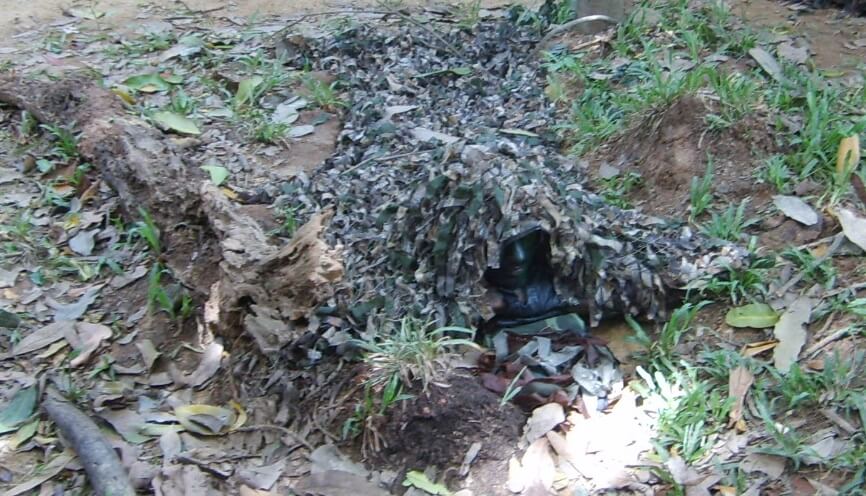Camouflage is a form of protection. The military has been using camouflage for soldiers since the mid-18th century to deceive and avoid enemies, or make it difficult to accurately hit their men and materiel. By using camouflage, an effective method of concealment, you too can remain unseen and thus avoid capture or becoming a target. It’s also the prescribed way of making yourself harder to spot by game animals as you stalk and hunt them, allowing you to get close enough for the kill.
In this article, we show you how to use camouflage and reap the benefits of avoiding detection.
The Basics
Camouflage can be used to fool observers and conceal yourself or mimic something else like a tree or bush. Either way, the main objective of an effective camouflage scheme is to ensure that you aren’t detected, at least not easily.
The most basic way of camouflaging yourself is to make certain that you don’t stick out like a sore thumb, by wearing clothing that has the same color or colors as your hunting grounds or the area where you operate. More than simply wearing colors to match the environment, you’ll need to “break up” your shape or silhouette.
“Break” Your Silhouette, Blend with the Surroundings
Even if the color of your clothing happens to match your surroundings, you’ll still be visible as a person-shaped figure. To avoid being spotted, you’ll have to break up your silhouette or shape. This is done simply by wearing more complicated camouflage pants, a jacket or shirt and headwear with camo patterns that include splotches, spots, stripes, patches or any combination of these. Ideally, the patterns should mimic the features of your area of operations, like patches of vegetation, underbrush, tall grass, trees or patches of soil.
Commercially-available hunting patterns vs. Military patterns
As you search for viable choices for camouflage, you’ll notice a wide range of choices, and camo patterns will fall under two general categories: commercial hunting and military patterns. In most cases, hunting patterns tend to closely mimic natural vegetation from specific areas hunters frequent. Military patterns tend to use a variety of unnatural shapes and use combat theatre-specific colors. Many contemporary military patterns even used pixilated shapes to try to address modern optics and detection devices.

The most common environments that camouflage patterns are designed for are:
- Woodland
- Desert
- Jungle
- Snow



(Heddels.com/2015/01/understanding-camo-13-patterns-know/).


Don’t Go Black
You may wonder why an entirely-black outfit isn’t used for camo, and it’s simply because black isn’t a naturally-occurring color in the outdoors. Unless you’re passing through or operating in an oil slick, tar pits or a burnt forest, use black clothing only for better concealment at night. And, even then, it ought to be broken up with other dark colors to reduce your silhouette.
Use Camouflaged Accessories
Apart from camo clothing, remember that you’ll have to camouflage the exposed skin on your face, neck and hands. Wear a boonie hat or bandanna with the same camo as your clothes. This is will break up the outline of your head. You should likewise wear similarly-camouflaged gloves. If using a large backpack or bug-out bag, get them in the same camo pattern or use a camouflage bag cover. For your hide or campsite, procure camouflaged items like a camo tarp or tent if you can’t use local vegetation and keep it fresh.
Use Camo Paint on Exposed Skin
Camouflage paint consisting of colors that match your camo scheme can be used instead of wearable accessories. Apply them in an irregular pattern on exposed skin, such as your face, neck and ears. Remember to apply them asymmetrically, as symmetrical patterns rarely occur in nature and might otherwise ruin an effective camo job. You can also paint your hands if you don’t have gloves. For the face, remember to paint over your eyelids and under the chin to avoid any unmasked areas.

Use Available Foliage
To up the ante on your concealment game, you can trim short branches of foliage and tie them to the band of your boonie hat or attach them to your clothing.
Another good way to use foliage is to wear a Ghillie suit, which is a net or cloth garment you wear over your camo clothing; it’s usually covered in loose strips of burlap and other lightweight fabrics, cloth or twine and you can attach plants local to the area to further enhance your concealment. When used properly and garnished with foliage, a Ghillie suit can help you virtually disappear into your surroundings. Do keep in mind that such suits require stationary usage — any sudden movements may be amplified by the twigs and foliage that cover the suit. Ghillie suits will also hinder mobility, and should be discarded when running in a flight scenario.

Final Notes
Even if you’re a civilian, you definitely have use for camouflage clothing and other items for concealment, especially when SHTF. The next time you go on a hiking or camping trip, try out a few camo items and “test” them with your friends or family members. You can even make a game out of it by playing a more challenging version of “hide and seek”.
For a more rewarding test of your camo skills, apply them the next time you go hunting for any wild game. Whether you’re evading enemies or hunting for food, knowing how to use camouflage effectively is a valuable survival skill to have. After all, you can’t be a target if you can’t be seen.
For some other ideas about camouflage in different scenarios, check out this ASG article on how to be the gray man.


